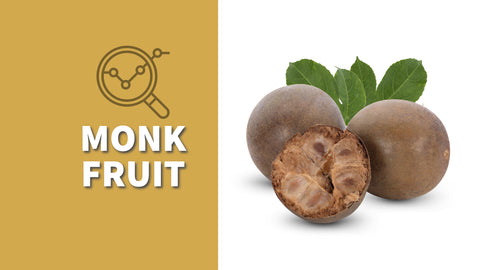Monk fruit extract, also known as Luo Han Guo extract, is a natural sweetener used in Energy Pods and CocoZen and derived from the monk fruit, a small, round fruit native to Southeast Asia. The fruit has been used for centuries in traditional Chinese medicine and as a sweetener. The extract is known for its intense sweetness, which can be up to 200 to 300 times sweeter than sugar, yet it contains no calories and does not raise blood sugar levels. This unique characteristic makes it a popular choice for those looking to reduce sugar intake or manage diabetes.
How is Monk Fruit Extract Obtained?
The process of obtaining monk fruit extract involves several steps:
- Harvesting: The monk fruit is harvested when it reaches full ripeness to ensure maximum sweetness.
- Crushing and Infusing: The fruit is crushed to release its juice, which is then infused in hot water.
- Filtering and Concentrating: The infusion is filtered to remove impurities and then concentrated to increase the sweetness level.
- Drying: The concentrated juice is dried, typically using a spray-drying process, to produce a fine powder that is the monk fruit extract.
This process ensures that the natural sweetness of the fruit is preserved without any need for artificial additives or chemicals.
Typical Applications of Monk Fruit Extract
Monk fruit extract is versatile and can be used in various applications, including:
- Food and Beverages: It is commonly used as a sweetener in foods and beverages, such as teas, juices, yogurts, and baked goods.
- Dietary Supplements: Due to its zero-calorie nature, it's often found in dietary supplements, particularly those aimed at weight management or sugar control.
- Sugar Alternatives: Monk fruit extract is a popular substitute for sugar in cooking and baking, offering a way to sweeten dishes without the added calories or impact on blood sugar levels.
Types of Monk Fruit Extracts
Monk fruit extracts, typically yellow-orange, are primarily categorized based on their mogroside content. Mogrosides are the natural compounds responsible for the fruit's sweetness. The most common types include:
- Mogroside V: The purest form of monk fruit sweetness, offering the highest intensity of sweetness.
- Mogroside IV: Slightly less sweet than Mogroside V, but still much sweeter than sugar.
- Blends of different mogrosides: Some extracts combine various mogrosides to achieve a specific sweetness profile and flavor.
Additionally, monk fruit extracts are often labeled with a percentage indicating the concentration of mogrosides. This percentage can range from 5% to 50% or higher, reflecting the purity and sweetness intensity of the extract. For example:
- 5% Mogroside content: This is a lower concentration, offering a milder sweetness. It's often used in products where only a slight sweetness is desired.
- 25% Mogroside content: A medium concentration, suitable for general sweetening purposes.
- 50% Mogroside content or higher: These are high-purity extracts, that provide intense sweetness. They are often used in products where a strong sweetening effect is needed, and only a small amount of the extract is required to achieve the desired sweetness level.
The choice of mogroside concentration depends on the intended application and the desired level of sweetness in the final product. Higher mogroside content typically correlates with greater sweetness intensity and is more cost-effective due to the smaller quantities needed. Typical monk fruit baking mixes in grocery stores have bulking sweeteners such as erythritol and xylitol combined with monk fruit extract to counter the intense sweetness of the extract.
Health Benefits of Monk Fruit
Fat Loss Benefits
Monk fruit contains zero calories but packs a powerful punch of sweetness. When you add it to your food, it can reduce the calories that come with sweet foods. Generally, what comes with the sweetener seems to be the main problem when it comes to fat gain rather than the sweetener itself. In the case of monk, it's a great add-on to your diet and it doesn't seem to increase energy intake on its own(1)
A Natural Anti-oxidant
Monk fruit extract can have an anti-oxidant effect(2) that can potentially scavenge reactive oxygen species. In cell cultures, it has been shown to have anti-aging properties(3)(4). This effect hasn't been noted in human trials as of yet. In rodents, it has been shown to protect against allergic asthma(5). In mice, it was shown to have some protective effects against acute lung injury(6).
Anti-cancer potential
When it comes to anti-cancer the research is limited to pancreatic cancer in cell and rodent models(7). Hence, the research is very limited in its practicality but can be interesting in the future.
Anti-Diabetic
Monk fruit extract has a negligible impact on blood sugar and insulin(8). and has no impact on energy intake either. This makes it a great product to reduce blood glucose response while still adding sweetness to foods. Unlike some other sweeteners such as xylitol, it isn't toxic to dogs in semi-chronic doses(9).
Good for throat
Monk fruit has been used in traditional Chinese medicine to help alleviate issues about the throat. In a randomized study(10), monk fruit extract helped alleviate symptoms of throat pain, hoarseness, throat swelling, and throat pain.
Protects the teeth
Monk fruit extract doesn't harm teeth and in fact, may have protective capabilities for teeth(11) in certain bacteria especially since dental complications can cost lots of money and loss in productivity.
FAQ about Monk Fruit Extract
Is monk fruit extract safe?
Yes, monk fruit extract is generally recognized as safe (GRAS) by the U.S. Food and Drug Administration (FDA).
Does monk fruit extract have an aftertaste?
Some people may notice a slight fruity aftertaste, but it is generally less pronounced than the aftertaste of some other sweeteners.
Can monk fruit extract be used in cooking and baking?
Yes, it is heat-stable and can be used in cooking and baking, though it's important to adjust the quantity due to its higher sweetness compared to sugar.
Is monk fruit extract suitable for diabetics?
Yes, it does not raise blood sugar levels, making it a suitable sweetener for people with diabetes.
How should monk fruit extract be stored?
It should be stored in a cool, dry place away from direct sunlight. Once opened, keeping it in an airtight container can help maintain its quality.
What does monk fruit extract taste like?
Monk fruit extract has a sweet taste similar to sugar but with a distinct, slightly fruity undertone. The level of sweetness can vary depending on the concentration of the extract, but it generally provides a clean, sweet flavor without the bitterness associated with some artificial sweeteners.
How much monk fruit extract can I eat per day?
There is no established upper limit for monk fruit extract consumption, as it is considered safe and non-toxic. However, like with any sweetener, it's recommended to use it in moderation. Since it is much sweeter than sugar, a small amount is usually sufficient to achieve the desired level of sweetness.
Is monk fruit extract a natural sweetener?
Yes, monk fruit extract is a natural sweetener. It is derived from the monk fruit without the addition of synthetic chemicals or artificial ingredients, making it a natural alternative to sugar and artificial sweeteners.

